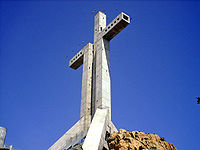Coquimbo Region
This article needs additional citations for verification. (August 2010) |
Template:Infobox Chilean region





The IV Coquimbo Region (Template:Lang-es) is one of Chile's 15 first order administrative divisions. It is some 400 km north of the capital, Santiago.
The capital and largest city is La Serena, other important cities include the seaport Coquimbo and the agricultural centre Ovalle.

Geography and ecology
The Coquimbo Region forms the narrowest part, or 'waist' of Chile, and is hence one of the country's more mountainous regions, as the Andes range runs closer to the sea than elsewhere. The region has notable marine species as well as taxa that are associated with the mountainous regions. With respect to marine organisms, the upwelling areas encourage bioproductivity off of this Pacific Coast area of Chile.[1]
In the southern mountainous areas of the Coquimbo Region, the rare and endangered Chilean Wine Palm is found, whose habitat is threatened by human overpopulation in the region and associated deforestation for residential expansion and agriculture.[2]
The Elqui Valley is home to a number of astronomical observatories,[3] owing to the region's clear skies. It is also home to a 600-meter-long dam, the Puclaro, which confines the Elqui River and produces a reservoir of some seven km in length.
Demography
Mining and agricultural activities account for the location of various places in the region, around the transverse valleys and mineral deposits. Originally this organization was structured according to the location of Indian villages of the Diaguitas. A high percentage (70-75%) of inhabitants are of Mestizo (Euro-Amerindian) background, higher than any other region in Chile. Other indigenous peoples include the Aymara, Atacameno, Mapuche and Quechua whom were immigrants themselves from Peru and Bolivia.
Some substantial immigration from Europe (a good number were Basques and Andalusians from Spain, with Croats, Greeks, Italians, and of Occitan-French and Galician/Portuguese descent), the Middle East (esp. Palestinians), other Latin American nations, North Americans (about tens of thousands claimed Cherokee ancestry from displaced persons from Indian Territory in the United States in the 1880s) and East Asians (mostly Chinese and Koreans) taken place in the Coquimbo region. In the late 19th and 20th century, a mass migration of Chileans from the Central Valley of Chile transformed the once culturally isolated and rural agrarian part of the country to fulfilled economic development goals.
Recent high population growth stresses the conurbation La Serena-Coquimbo (est. 300,000 or 297.253 inhabitants), which concentrates half the regional population. In terms of population, major cities are (according to the 2002 census): La Serena (148.815) Coquimbo (148.438) Ovalle (66.405) Illapel (21.826) Vicuña (12.910) Salamanca (11.615) and Los Vilos (10.966).
Economy
This region is a very popular travel destination. Visitors are mainly attracted to its long beaches, many of fine white sand, bathed by a calm sea, and the region’s pleasant climate.
Along with tourism, the province's main industries are agriculture and fishing.
The Los Pelambres copper mine, near Salamanca in Choapa is one of the largest in the world with some 2,100 million tonnes of reserves.
Communications
Printed press
The first newspaper published in this region was El Minero de Coquimbo in 1828. In La Serena is published the newspaper El Día (founded on April 1, 1944) and the Weekly Tiempo (founded on 13 November 1993), while in the Coquimbo is printed La Región (founded on April 13, 2004) and the newspaper El Ovallino in Ovalle (founded on October 15, 1989).
TV
In television TVN Red Coquimbo began on June 28, 1993, news segments broadcast signal within the country. Then conduct small programs with reports in the local accent.
In cable television, there is CuartaVisión channel in the UHF signal cable 3 VTR and the TV signal 2 open Ovalle, transmitting content regional productions and local customs, traditions, sports, art, etc..
In Ovalle, the council passed on UHF channel 63 of the Cable Color Ovalle TV, originally called "Cultura Televisión." This channel will broadcast news and documentaries from Limarí.
And have now ceased to exist several regional signals as Telenorte launched in the 1960s, and had a studio in La Serena in 1993, which ended in 1998. The signal issued from Arica continued until 2001, when it was closed forever. Another regional channel, now gone, was the Canal 8 UCV TV. Identified as a local affiliate signal UCV TV, received support from the Valparaíso station and, with great technical support, made soap operas and other shows. This channel in 1994 changed to signal the signal 9, until in 2002 finally closed its doors, leaving the memory of more than 25 years of history of local communications.
In La Serena and Coquimbo are captured the following TV signals open:
- TVN (4 VHF signal)
- Canal 13 (VHF signal 13)
- Megavisión (11 VHF signal)
- Chilevision (2 VHF signal)
- Red TV (VHF signal 7)
- UCV TV (9 VHF signal)
- Telecanal (5 VHF signal)
Notable people
- Nobel Laureate poet Gabriela Mistral was a native of Vicuña, in the Elqui Valley, a Pisco producing area.[4]
References
- ^ R.N. Gibson, R.J.A. Atkinson and J.D.M. Gordon, 2007
- ^ C. Michael Hogan, 2008
- ^ Frier Hansen, Henrik (2008). Viva Chile: Travels, Tips and Tales. AuthorHouse. p. 26. ISBN 1467020672.
- ^ "Gabriela Mistral - Biographical - Nobel Peace Prize". nobelprize.org. Retrieved 25 January 2014.
- R.N. Gibson, R.J.A. Atkinson and J.D.M. Gordon (2007) Oceanography and Marine Biology: An Annual Review, CRC Press, 560 pages ISBN 1-4200-5093-1
- C. Michael Hogan (2008) Chilean Wine Palm: Jubaea chilensis, GlobalTwitcher.com, ed. Nicklas Stromberg
External links
- Gobierno Regional de Coquimbo Official website Template:Es icon


